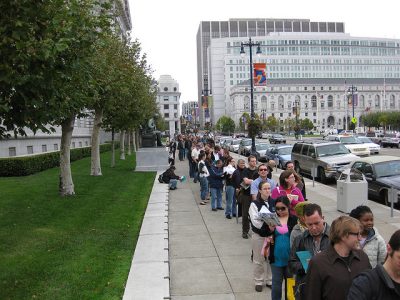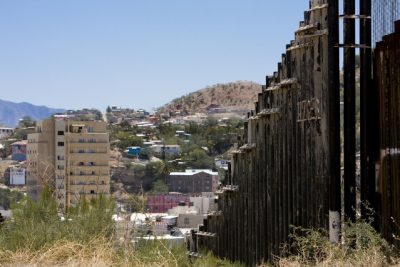Demographics
Immigrants are a vital, dynamic part of the U.S. population—especially when it comes to the workforce. 77.1% of immigrants are of working age (16–64), compared to just 62.0% of U.S.-born residents, making them key contributors to the economy as both taxpayers and consumers.
- 22.9 million immigrants are active in the U.S. workforce
- 74% of foreign-born residents are proficient in English
- 89.4% of all undocumented immigrants are of working age
- 5.2 million U.S. citizen children living with at least one undocumented family member
- Only 4.9% of immigrants are under 15, compared to 20.3% of U.S.-born residents
- 18% of immigrants are 65+, nearly identical to the 17.7% of U.S.-born seniors

A Long Journey to the Voting Booth
For some people, this year’s journey to the voting booth started years ago, in El Salvador or China or Cameroon, when it became clear that they had to leave their country and start over in America. For those people, (whom U.S. Citizenship and Immigration Services calls “Americans by choice,”) the journey to the polls has involved hardship, struggle, hundreds of hours learning English and civics, and studying for the naturalization test. They bring not only their vote to the polls, but a reminder to all of us that our precious democracy can only succeed when we believe in this country enough to take the time to vote. Read More

Nativist Group Releases Hopelessly Flawed Report on Immigrants and Job Creation
By Patrick Oakford, Research Assistant for the Economic Policy Team at the Center for American Progress. Last week the Center for Immigration Studies (CIS) released a shocking report claiming that most new jobs created under President Obama have gone to immigrants. Aside from the sheer incorrectness of the claim, being founded on flawed methodologies, CIS perpetuates a hateful “us versus them” discourse at a time when we should be focused on creating more and longer-lasting jobs. Read More

Immigrant Workers Likely to Play Big Role in Post-Sandy Reconstruction
Hurricane Sandy may be gone, but the monumental task of reconstruction remains. In New Jersey and New York in particular, thousands of workers will be needed to rebuild or restore roads, homes, and office buildings damaged or destroyed by the storm. If history is any guide, many of those workers will be immigrants, and many of those immigrants will be unauthorized. Ironically, as they play an outsized role in reconstruction after a natural disaster, immigrant workers will be especially vulnerable to abuse and exploitation by unscrupulous employers. As a result, federal and state officials must be vigilant in ensuring that labor laws are vigorously enforced to protect all workers involved in post-Sandy reconstruction efforts. Read More

Immigrants Play Key Role in Virginia’s Economy
Recent state-level immigration battles are often characterized by a great deal of negative attention and not enough positive information about immigrants living in those states. Unfounded claims about the costs of immigration overlook the benefits and contributions immigrants make to American communities. Fortunately, some organizations are dedicated to pushing back on the negativity and publishing accurate data about the role immigrants play in state economies. Read More

New Research Casts Doubt Upon “Attrition Through Enforcement”
Contrary to the expectations of anti-immigrant activists, unauthorized immigrants are not leaving the United States and returning home en masse in response to the onslaught of federal, state, and local immigration-enforcement initiatives in recent years. In fact, preliminary evidence indicates that unauthorized immigration to the United States from Mexico may be inching its way upward again for the first time since the Great Recession. Why? Because unauthorized immigration responds far more to the state of the U.S. economy than it does to the intensity of U.S. immigration enforcement. This casts considerable doubt upon the nativist creed of “attrition through enforcement”—the belief that making life difficult enough for unauthorized immigrants will motivate them to “self-deport.” Read More

Associated Press Issues Misleading Defense of Term “Illegal Immigrant”
Unlike lawyers and policymakers, journalists have an obligation to use language that ordinary people understand. Although the practice is generally helpful, it can sometimes result in oversimplification, or sacrificing accuracy for the sake of supposed clarity. A perfect example is the memo issued by the Associated Press last week endorsing use of the term “illegal immigrant.” Read More

ICE Scaling Back 287(g) Program
The 287(g) program has been controversial and criticized for years, and immigrant advocates have demanded that US Immigration and Customs Enforcement (ICE) terminate the program. Section 287(g) of the INA allows the Secretary of Homeland Security to enter into agreements that delegate immigration powers to local police, but only through negotiated agreements, documented in Memoranda of Agreement (MOAs). The task force model deputizes police to enforce immigration laws in the course of their regular activities on the streets, and the jail model places deputized police officers within jails. A recent development raises questions about the future of the program. Read More

A Growing Consensus on Supporting Immigration Reform
Immigration reform is not a “liberal” cause; it is a common-sense cause that appeals to people from a variety of political persuasions. More than a few conservative intellectuals, commentators, politicians, religious leaders, and law-enforcement officials favor revamping the U.S. immigration system to make it more responsive to the economic demands, social realities, and security concerns of the 21st century. This stance represents not only compassion, but enlightened self-interest. A growing body of evidence has quantified the enormous contributions that immigrants make to the U.S. economy through their labor, entrepreneurship, buying power, and innovation. Moreover, demographic trends point clearly to the growing electoral power of naturalized immigrants and to the native-born children of immigrants. In other words, being anti-immigrant in this day and age is self-destructive from both an economic and a political standpoint. Read More

Lifting Up Cities That Are Welcoming Immigrants
When it comes to immigration policymaking at the state and local level, all eyes have been focused for quite some time on train wrecks like Arizona and Alabama. These are places in which policymakers have chosen to deal with unauthorized immigration by embarking on a path of economic self-destruction—blindly lashing out at immigrants and Latinos no matter what the cost in terms of wasted taxpayer money, labor-force contraction, lost economic growth, community upheaval, and violations of fundamental human rights. Read More

Congress Pits One Form of Legal Immigration Against Another
We recently noted that the only point of agreement in the Republican and Democratic platforms on immigration was on the need for an infusion of green cards for STEM (science, technology, engineering, and math) graduates with advanced degrees from American colleges and universities. A recent poll conducted for the Partnership for a New American Economy and Compete America shows that 76 percent of Americans support the idea as well. If only Congress could draft legislation that simply sought to put that idea into practice. Read More
Make a contribution
Make a direct impact on the lives of immigrants.
